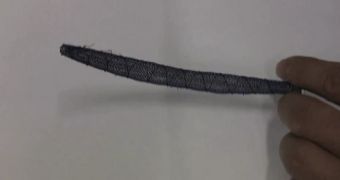We were wondering when the folks at the Massachusetts Institute of Technology would have something new for us, and upon seeing their latest project we can easily say that they have definitely delivered.
What we have in the video embedded below, and the photo up on the left, is the newest creation from researchers at MIT, Harvard University and Seoul National University
Called “Meshworm”, it is a flexible mesh tube encircled by loops of nickel and titanium wire. The wire is the “muscle” of sorts.
The goal was to create something that moves via peristalsis, crawling across surfaces, so the locomotion of an earthworm was used as a starting point.
The mesh doesn't do anything on its own, but when the loops of wire are heated (by running electricity through them), they squeeze it, causing it to expand and contract in “rings.”
“Even though the robot’s body is much simpler than a real worm — it has only a few segments — it appears to have quite impressive performance,” says Kellar Autumn, a professor of biology at Lewis and Clark College.
“I predict that in the next decade we will see shape-changing artificial muscles in many products, such as mobile phones, portable computers and automobiles.”
The team of researchers expects the Meshworm to prove useful in navigating rough terrain or in the making of next-generation endoscopes, implants and prosthetics.
Finally, the worm is remarkably damage-resistant. Even after multiple blows with the hammer, it just dragged itself away without any deformities.
“You can throw it, and it won’t collapse,” says Sangbae Kim, the Esther and Harold E. Edgerton assistant professor of mechanical engineering at MIT.
“Most mechanical parts are rigid and fragile at small scale, but the parts in Meshworms are all fibrous and flexible. The muscles are soft, and the body is soft... we’re starting to show some body-morphing capability.”

 14 DAY TRIAL //
14 DAY TRIAL // 